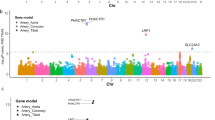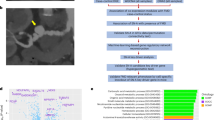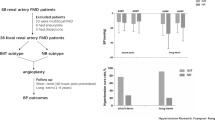Abstract
A significant knowledge gap exists regarding characteristics of fibromuscular dysplasia (FMD) in Asian patients compared to Caucasian populations. This meta-analysis evaluated FMD characteristics in Asia (PROSPERO ID: CRD42024596516). PubMed, EMBASE, Cochrane Library, Web of Science, VIP, CNKI, and Wanfang databases were searched for observational studies after January 1, 2000, focusing on FMD in Asian populations. Twenty-four studies including 1254 Asian participants (1059 Chinese, 134 Japanese, and 61 others) were analyzed. Among Asian FMD patients, 59.0% (95% CI: 54.3–63.5%) were women, and mean age at FMD diagnosis was 28.6 years (26.7–30.6 years). Multifocal FMD was diagnosed in 38.4% (28.5–48.8%) of participants, and multivessel FMD in 12.7% (4.6–23.6%). Aneurysms and dissections were reported in 13.5% (7.8–20.4%) and 9.0% (1.8–19.9%) of participants, respectively. 99.9% (98.6–100.0%) of patients were hypertensive, 7.6% (5.3–10.2%) had a history of stroke and 40.3% (22.2–59.8%) reported headache. Bilateral renal artery involvement was documented in 17.9% (13.5–22.6%) of participants, and renal atrophy in 29.9% (24.4–35.6%). Compared with Japanese patients, Chinese patients were younger (26.2 vs. 36.2 years, P < 0.001). Furthermore, the proportion of women (59.4% vs. 64.3%, P = 0.334), and multifocal FMD (33.4% vs. 51.6%, P = 0.085) tended to be lower in Chinese versus Japanese patients. In conclusion, compared to published data in Caucasian patients, Asian FMD patients were younger, more often men, with focal FMD, and had lower rates of multivessel involvement, aneurysms, and dissections. Similar trends were found both in Chinese and Japanese patients.

Our meta-analysis showed that compared to published data in Caucasian patients, Asian patients with FMD were younger, more often men, with focal FMD, and had lower rates of multivessel involvement, aneurysms, and dissections. Similar trends were found both in Chinese and Japanese patients.
This is a preview of subscription content, access via your institution
Access options
Subscribe to this journal
Receive 12 print issues and online access
$259.00 per year
only $21.58 per issue
Buy this article
- Purchase on SpringerLink
- Instant access to full article PDF
Prices may be subject to local taxes which are calculated during checkout





Similar content being viewed by others
Data availability
Additional data available from the corresponding author at alexandre.persu@saintluc.uclouvain.be.
References
Gornik HL, Persu A, Adlam D, Aparicio LS, Azizi M, Boulanger M, et al. First International Consensus on the diagnosis and management of fibromuscular dysplasia. Vasc Med. 2019;24:164–89.
Persu A, Giavarini A, Touze E, Januszewicz A, Sapoval M, Azizi M, et al. European consensus on the diagnosis and management of fibromuscular dysplasia. J Hypertens. 2014;32:1367–78.
Pappaccogli M, Di Monaco S, Warchol-Celinska E, Lorthioir A, Amar L, Aparicio LS, et al. The European/International Fibromuscular Dysplasia Registry and Initiative (FEIRI)-clinical phenotypes and their predictors based on a cohort of 1000 patients. Cardiovasc Res. 2021;117:950–9.
Savard S, Steichen O, Azarine A, Azizi M, Jeunemaitre X, Plouin PF. Association between 2 angiographic subtypes of renal artery fibromuscular dysplasia and clinical characteristics. Circulation. 2012;126:3062–9.
Lather HD, Gornik HL, Olin JW, Gu X, Heidt ST, Kim ESH, et al. Prevalence of intracranial aneurysm in women with fibromuscular dysplasia: a report from the US registry for fibromuscular dysplasia. JAMA Neurol. 2017;74:1081–7.
Olin JW, Froehlich J, Gu X, Bacharach JM, Eagle K, Gray BH, et al. The united states registry for fibromuscular dysplasia: results in the first 447 patients. Circulation. 2012;125:3182–90.
Olin JW, Gornik HL, Bacharach JM, Biller J, Fine LJ, Gray BH, et al. Fibromuscular dysplasia: state of the science and critical unanswered questions: a scientific statement from the American Heart Association. Circulation. 2014;129:1048–78.
Kang Y, Wu Q, Xu J, Hong M, Ma Y, Tang X, et al. Intravascular ultrasound provides additional insights in the hypertensive patients with focal renal artery fibromuscular dysplasia. Hypertens Res. 2023;46:1407–16.
Mishima E, Umezawa S, Suzuki T, Fujimura M, Abe M, Hashimoto J, et al. Low frequency of cervicocranial artery involvement in Japanese with renal artery fibromuscular dysplasia compared with that of Caucasians. Clin Exp Nephrol. 2018;22:1294–9.
Stroup DF, Berlin JA, Morton SC, Olkin I, Williamson GD, Rennie D, et al. Meta-analysis of observational studies in epidemiology: a proposal for reporting. Meta-analysis Of Observational Studies in Epidemiology (MOOSE) group. JAMA. 2000;283:2008–12.
Wan X, Wang W, Liu J, Tong T. Estimating the sample mean and standard deviation from the sample size, median, range and/or interquartile range. BMC Med Res Methodol. 2014;14:135.
马志岭, 周志斌, 化召辉, 焦周阳, 徐鹏, 曹辉, et al. 肾动脉纤维肌性发育不良致肾血管性高血压的诊断与治疗. 中华普通外科杂志. 2022;37:447-51.
Munn Z, Barker TH, Moola S, Tufanaru C, Stern C, McArthur A, et al. Methodological quality of case series studies: an introduction to the JBI critical appraisal tool. JBI Evid Synth. 2020;18:2127–33.
Lu Y, Shang Z, Zhang W, Pang M, Hu X, Dai Y, et al. Global incidence and characteristics of spinal cord injury since 2000-2021: a systematic review and meta-analysis. BMC Med. 2024;22:285.
Higgins JP, Thompson SG, Deeks JJ, Altman DG. Measuring inconsistency in meta-analyses. BMJ. 2003;327:557–60.
Higgins JP, Thompson SG. Quantifying heterogeneity in a meta-analysis. Stat Med. 2002;21:1539–58.
Tufanaru C, Munn Z, Stephenson M, Aromataris E. Fixed or random effects meta-analysis? Common methodological issues in systematic reviews of effectiveness. Int J Evid Based Healthc. 2015;13:196–207.
Bell A, Fairbrother M, Jones K. Fixed and random effects models: making an informed choice. Quality & Quantity. 2019;53:1051–74.
Egger M, Davey Smith G, Schneider M, Minder C. Bias in meta-analysis detected by a simple, graphical test. BMJ. 1997;315:629–34.
Lin L, Chu H, Murad MH, Hong C, Qu Z, Cole SR, et al. Empirical comparison of publication bias tests in meta-analysis. J Gen Intern Med. 2018;33:1260–7.
Liu CH, Wu D, Chin SC, Fu SC, Wu TC, Chang CH, et al. Cervicocranial fibromuscular dysplasia in Taiwanese ischemic stroke patients. Eur Neurol. 2012;67:129–35.
Yang YK, Zhang Y, Meng X, Yang KQ, Jiang XJ, Wu HY, et al. Clinical characteristics and treatment of renal artery fibromuscular dysplasia with percutaneous transluminal angioplasty: a long-term follow-up study. Clin Res Cardiol. 2016;105:930–7.
Wang J, Chen T, Wang Q, Wang Q, Guo J. Clinical efficacy of percutaneous transluminal angioplasty in treatment of renal artery stenosis resulting from fibromuscular dysplasia. Chinese Journal of Interventional Imaging and Therapy. 2018;15:217–20.
Iwashima Y, Fukuda T, Kusunoki H, Hayashi SI, Kishida M, Yoshihara F, et al. Effects of percutaneous transluminal renal angioplasty on office and home blood pressure and home blood pressure variability in hypertensive patients with renal artery stenosis. Hypertension. 2017;69:109–17.
Peng M, Jiang XJ, Dong H, Zou YB, Zhang HM, Song L, et al. Etiology of renal artery stenosis in 2047 patients: a single-center retrospective analysis during a 15-year period in China. J Hum Hypertens. 2016;30:124–8.
Iwashima Y, Fukuda T, Yoshihara F, Kusunoki H, Kishida M, Hayashi SI, et al. Incidence and risk factors for restenosis, and its impact on blood pressure control after percutaneous transluminal renal angioplasty in hypertensive patients with renal artery stenosis. Journal of Hypertension. 2016;34:1407–15.
Hyo JK, Young SD, Sung WS, Kwang BP, Sung KC, Yeon HC, et al. Percutaneous transluminal angioplasty of renal artery fibromuscular dysplasia: Mid-term results. Korean Journal of Radiology. 2008;9:38–44.
Kang YY, Chen Y, Wu QH, Dong H, Zou YB, Gao PJ, et al. Prevalence and clinical characteristics of renovascular hypertension associated with fibromuscular dysplasia in China. J Hypertens. 2023;41:638–47.
Fujihara M, Fukata M, Higashimori A, Nakamura H, Odashiro K, Yokoi Y. Short- and mid-term results of balloon angioplasty for renal artery fibromuscular dysplasia. Cardiovasc Interv Ther. 2014;29:293–9.
Kumar A, Dubey D, Bansal P, Sanjeevan KV, Gulati S, Jain S, et al. Surgical and radiological management of renovascular hypertension in a developing country. J Urol. 2003;170:727–30.
Xiong H-l, Peng M, Jiang X-j, Che W-q, Dong H, Chen Y, et al. Time trends regarding the etiology of renal artery stenosis: 18 years’ experience from the China Center for Cardiovascular Disease. Journal of Clinical Hypertension. 2018;20:1302–9.
Yang Z, Zhang Z, Ji R, Yu Y, Ni X, Hu Y, et al. Ultrasonography for evaluation of renal artery stenosis caused by fibromuscular dysplasia. Chinese Journal of Medical Imaging Technology. 2022;38:730–3.
崔云英, 王芬, 童安莉, 张响华, 李玉秀. 纤维肌性发育不良致肾血管性高血压的临床特征及诊断治疗. 基础医学与临床. 2019;39:381-4.
吴艳, 蒋雄京, 吴海英, 张慧敏, 郑德裕, 惠汝太, et al. 经皮血管成形术治疗肾动脉纤维肌性发育不良的临床疗效. 中国分子心脏病学杂志. 2012;12:162-5.
蒋雄京, 吴艳, 杨倩, 吉薇, 吴海英, 张慧敏, et al. 经皮血管成形术治疗肾动脉纤维肌性发育不良的临床结果. 中华高血压杂志. 2010;18:643-7.
王博, 吴忠隐, 郭伟, 刘小平, 贾鑫, 张宏鹏. 肌纤维发育不良型肾动脉狭窄腔内治疗临床分析. 中华实用诊断与治疗杂志. 2014;28:490-1,3.
史振宇, 符伟国, 郭大乔, 陈斌, 徐欣, 蒋俊豪, et al. 肌纤维发育不良所致肾动脉狭窄16例的治疗. 中华普通外科杂志. 2012;27:786-8.
陈阳, 董徽, 华倚虹, 马文韬, 邓宇, 何际宁, et al. 肾动脉纤维肌性发育不良患者临床与血管造影特征的18年单中心病例总结. 中国循环杂志. 2021;36:451-7.
曹茂盛, 黄卫华, 陈爱华, 尚斌. 肾动脉纤维肌性发育不良的CTA诊断价值. 临床放射学杂志. 2014;33:1724-8.
上官海娟, 蒋雄京, 董徽, 彭猛, 邹玉宝, 关婷, et al. 肾动脉纤维肌性发育不良的临床和造影特征:单中心十年回顾. 中国循环杂志. 2014;29:272-4.
张源明, 罗健, 何秉贤, 古丽巴哈尔. 肾血管性高血压103例临床分析. 中华高血压杂志. 2007;15:859-60.
Lu YT, Zhou ZM, Zhang D, Sun L, Liu XC, Yang YK, et al. Percutaneous transluminal renal angioplasty for fibromuscular dysplasia and prognostic risk factors: a retrospective chinese cohort study. J Clin Med. 2022;12:23.
Tian Y, Yuan B, Zhang N, Huang Z. Outcomes following the endovascular treatment of renal artery stenosis caused by fibromuscular dysplasia: a systematic review and meta-analysis. Ann Vasc Surg. 2022;78:362–72.
Trinquart L, Mounier-Vehier C, Sapoval M, Gagnon N, Plouin PF. Efficacy of revascularization for renal artery stenosis caused by fibromuscular dysplasia: a systematic review and meta-analysis. Hypertension. 2010;56:525–32.
Persu A, Dobrowolski P, Gornik HL, Olin JW, Adlam D, Azizi M, et al. Current progress in clinical, molecular, and genetic aspects of adult fibromuscular dysplasia. Cardiovasc Res. 2022;118:65–83.
Kiando SR, Tucker NR, Castro-Vega LJ, Katz A, D’Escamard V, Treard C, et al. PHACTR1 Is a genetic susceptibility locus for fibromuscular dysplasia supporting its complex genetic pattern of inheritance. PLoS Genet. 2016;12:e1006367.
Guo DC, Duan XY, Regalado ES, Mellor-Crummey L, Kwartler CS, Kim D, et al. Loss-of-Function Mutations in YY1AP1 Lead to Grange Syndrome and a Fibromuscular Dysplasia-Like Vascular Disease. Am J Hum Genet. 2017;100:21–30.
Georges A, Albuisson J, Berrandou T, Dupre D, Lorthioir A, D’Escamard V, et al. Rare loss-of-function mutations of PTGIR are enriched in fibromuscular dysplasia. Cardiovasc Res. 2021;117:1154–65.
Richer J, Hill HL, Wang Y, Yang ML, Hunker KL, Lane J, et al. A Novel Recurrent COL5A1 Genetic Variant Is Associated With a Dysplasia-Associated Arterial Disease Exhibiting Dissections and Fibromuscular Dysplasia. Arterioscler Thromb Vasc Biol. 2020;40:2686–99.
Savard S, Azarine A, Jeunemaitre X, Azizi M, Plouin PF, Steichen O. Association of smoking with phenotype at diagnosis and vascular interventions in patients with renal artery fibromuscular dysplasia. Hypertension. 2013;61:1227–32.
van Twist DJL, de Leeuw PW, Kroon AA. Renal artery fibromuscular dysplasia and its effect on the kidney. Hypertens Res. 2018;41:639–48.
Plouin PF, Perdu J, La Batide-Alanore A, Boutouyrie P, Gimenez-Roqueplo AP, Jeunemaitre X. Fibromuscular dysplasia. Orphanet J Rare Dis. 2007;2:28.
Lerman LO, Taler SJ, Textor SC, Sheedy PF 2nd, Stanson AW, Romero JC. Computed tomography-derived intrarenal blood flow in renovascular and essential hypertension. Kidney Int. 1996;49:846–54.
van Twist DJ, Houben AJ, de Haan MW, de Leeuw PW, Kroon AA. Pathophysiological differences between multifocal fibromuscular dysplasia and atherosclerotic renal artery stenosis. J Hypertens. 2017;35:845–52.
van Twist DJ, Houben AJ, de Haan MW, de Leeuw PW, Kroon AA. Renal hemodynamics and renin-angiotensin system activity in humans with multifocal renal artery fibromuscular dysplasia. J Hypertens. 2016;34:1160–9.
van Twist DJL, de Heer PWM, Houben A, de Haan MW, de Leeuw PW, Kroon AA. Differences in renal hemodynamics and renin secretion between patients with unifocal and multifocal fibromuscular dysplasia. J Hypertens. 2018;36:1729–35.
Acknowledgements
We would like to express our sincere gratitude to Dr. Zhiling Ma (the First Affiliated Hospital of Zhengzhou University) and Prof. Zhen Li (the First Affiliated Hospital of Zhengzhou University) for kindly providing additional data that were helpful for this study. Dr. Weiwei Wang is supported by the China Scholarship Council (CSC) for his PhD at the Catholic University of Louvain (UCLouvain). Prof. Alexandre Persu is Clinicien-Chercheur spécialiste qualifié of Fonds de Recherche Clinique of UCLouvain, Belgium.
Author information
Authors and Affiliations
Contributions
AP conceived the study and designed the protocol. WW, KZ, and TF performed the literature search. WW, MSS and AP selected the studies and extracted the relevant information. WW synthesized the data. WW wrote the first draft of the paper. MSS and AP are the study guarantors. All authors critically revised successive drafts of the paper and approved the final version. The corresponding author attests that all listed authors meet authorship criteria and that no others meeting the criteria have been omitted.
Corresponding author
Ethics declarations
Conflict of interest
The authors declare no competing interests.
Additional information
Publisher’s note Springer Nature remains neutral with regard to jurisdictional claims in published maps and institutional affiliations.
Supplementary information
Rights and permissions
Springer Nature or its licensor (e.g. a society or other partner) holds exclusive rights to this article under a publishing agreement with the author(s) or other rightsholder(s); author self-archiving of the accepted manuscript version of this article is solely governed by the terms of such publishing agreement and applicable law.
About this article
Cite this article
Wang, W., Xu, J., Fujimoto, T. et al. Characteristics of Asian patients with Fibromuscular Dysplasia: a systematic review and meta-analysis. Hypertens Res 48, 2184–2196 (2025). https://doi.org/10.1038/s41440-025-02248-2
Received:
Revised:
Accepted:
Published:
Issue date:
DOI: https://doi.org/10.1038/s41440-025-02248-2



